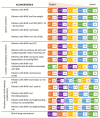Oral Anticoagulant Use and Appropriateness in Elderly Patients with Atrial Fibrillation in Complex Clinical Conditions: ACONVENIENCE Study
- PMID: 36556039
- PMCID: PMC9781896
- DOI: 10.3390/jcm11247423
Oral Anticoagulant Use and Appropriateness in Elderly Patients with Atrial Fibrillation in Complex Clinical Conditions: ACONVENIENCE Study
Abstract
Non-valvular atrial fibrillation (NVAF) is the most common arrhythmia in older patients. Although direct-acting oral anticoagulants (DOAC) are the antithrombotic treatment of choice, irrespective of age, certain factors may limit their use. The aim of the ACONVENIENCE study was to consult the opinion of a multidisciplinary panel of experts on the appropriateness of using OACs in elderly patients (>75 years) with NVAF associated with certain complex clinical conditions. A consensus project was performed on the basis of a systematic review of the literature, and application of a two-round Delphi survey. The agreement of 79 panellists on 30 Delphi-type statements was evaluated, and their opinion on the appropriateness of different oral anticoagulants in 16 complex clinical scenarios was assessed. A total of 27 consensus statements were agreed upon, including all statements addressing anticoagulation in older patients and in patients at high risk of bleeding complications, and most of those addressing frailty, dementia, risk of falling, and complex cardiac situations. It was almost unanimously agreed upon that advanced age should not influence the anticoagulation decision. Apixaban was the highest-rated therapeutic option in 14/16 situations, followed by edoxaban. There is a high degree of agreement on anticoagulation in older patients with NVAF. Age should not be the single limiting factor when prescribing OACs, and the decision should be made based on net clinical benefit and a comprehensive geriatric assessment. Apixaban, followed by edoxaban, was considered the most appropriate treatment in the various complex clinical situations examined.
Keywords: anticoagulants; antithrombins; atrial fibrillation; bleeding; drug interactions; factor Xa inhibitors; frail elderly; geriatric assessment; stroke.
Conflict of interest statement
C. Bonanad declares that she has received funding for attendance at meetings and conferences, and speaker fees from BMS/Pfizer, Daiichi-Sankyo, Boehringer and Bayer. F. Formiga received funding for attendance at meetings and congresses, honoraria and funding from Pfizer for attending meetings and congresses; speaker fees from BMS/Pfizer, Daiichi-Sankyo, and Bayer; and funding for participating in research by BMS/Pfizer. M. Anguita declares that he has received speaker fees from BMS/Pfizer, Novartis, Bayer, Daiichi-Sankyo and Boehringer, and funding for participating in research projects from BMS/Pfizer, Abbot, Novartis, Bayer, and Daiichi-Sankyo. R. Petidier declares that he has received speaker fees from Bayer, BMS/Pfizer and Daiichy-Sankyo. A. Gullón declares that she has received speaker fees from BMS/Pfizer and Bayer and funding for participating in a research project from Daiichi-Sankyo.
Figures


Similar articles
-
A Delphi consensus on the management of oral anticoagulation in patients with non-valvular atrial fibrillation in Spain: ACOPREFERENCE study.PLoS One. 2020 Jun 1;15(6):e0231565. doi: 10.1371/journal.pone.0231565. eCollection 2020. PLoS One. 2020. PMID: 32479502 Free PMC article.
-
Use of oral anticoagulants in complex clinical situations with atrial fibrillation.Med Clin (Barc). 2018 Jun;150 Suppl 1:8-24. doi: 10.1016/S0025-7753(18)30666-3. Med Clin (Barc). 2018. PMID: 30502871 Review. English, Spanish.
-
Frailty, Cognitive Impairment, and Anticoagulation Among Older Adults with Nonvalvular Atrial Fibrillation.J Am Geriatr Soc. 2020 Dec;68(12):2778-2786. doi: 10.1111/jgs.16756. Epub 2020 Aug 11. J Am Geriatr Soc. 2020. PMID: 32780497 Free PMC article.
-
Central American and Caribbean Consensus Document for the Optimal Management of Oral Anticoagulation in Patients with Non-Valvular Atrial Fibrillation Endorsed by the Central American and Caribbean Society of Arterial Hypertension and Cardiovascular Prevention.J Clin Med. 2024 Jan 5;13(2):314. doi: 10.3390/jcm13020314. J Clin Med. 2024. PMID: 38256448 Free PMC article.
-
Direct oral anticoagulants use in elderly patients with non valvular atrial fibrillation: state of evidence.Minerva Cardioangiol. 2018 Jun;66(3):301-313. doi: 10.23736/S0026-4725.17.04553-4. Epub 2017 Nov 10. Minerva Cardioangiol. 2018. PMID: 29125269 Review.
Cited by
-
Transfusion Risk Factors in Low-Energy Pelvic Fractures: A Retrospective Cohort Study.Geriatr Orthop Surg Rehabil. 2025 Jun 13;16:21514593251351557. doi: 10.1177/21514593251351557. eCollection 2025. Geriatr Orthop Surg Rehabil. 2025. PMID: 40519606 Free PMC article.
-
Direct Oral Anticoagulants as the First Choice of Anticoagulation for Patients with Peripheral Artery Disease to Prevent Adverse Vascular Events: A Systematic Review and Meta-Analysis.J Cardiovasc Dev Dis. 2023 Feb 3;10(2):65. doi: 10.3390/jcdd10020065. J Cardiovasc Dev Dis. 2023. PMID: 36826561 Free PMC article. Review.
-
Establishing a Validation Framework of Treatment Discontinuation in Claims Data Using Natural Language Processing and Electronic Health Records.Clin Pharmacol Ther. 2025 Jul;118(1):138-145. doi: 10.1002/cpt.3650. Epub 2025 Apr 8. Clin Pharmacol Ther. 2025. PMID: 40197528
References
-
- Gómez-Doblas J.J., Muñiz J., Martin J.J.A., Rodríguez-Roca G., Lobos J.M., Awamleh P., Permanyer-Miralda G., Chorro F.J., Anguita M., Roig E. Prevalence of Atrial Fibrillation in Spain. OFRECE Study Results. Rev. Esp. Cardiol. Engl. Ed. 2014;67:259–269. doi: 10.1016/j.recesp.2013.07.015. - DOI - PubMed
Grants and funding
LinkOut - more resources
Full Text Sources

